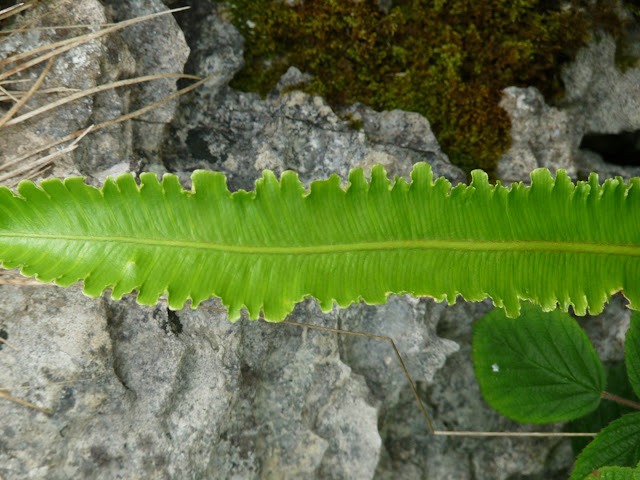Asplenium scolopendrium variety (Click over to enlarge)
Photo: Dalton Crags on 29th June 2019
Today I led a small party up through Dalton Crags and we then entered and explored the Common whilst checking out both the Green Spleenworts together with our beautiful Holly Ferns.
We tried to record our butterflies which were quite prolific on account of all the good weather we are getting and we did manage to records 7 Painted Ladies, at least 10 of the large fritillaries of which we did manage to confirm 2 or 3 to be Dark Green Fritillaries, we also had 2 Small Pearl Bordered fritillaries of which one was well worn and faded. 1 Red Admiral, 4 Ringlets, 10 Small Heaths, 6 Meadow Browns and one very small Wall Brown which loved settling in the areas of the foundations for the Trig point itself. We were also lucky to record 2x Cinnabar moths and also a Brown Silver Lines Moth and a Latticed Heath Moth.
Our birds were represented by Willow Warblers and young parties of birds as well, Garden Warblers, Great Spotted Woodpeckers, a Green Woodpecker and noisy Redpolls. We also had a beautiful male Stonechat on view which was giving off his chacking alarm call.
We did also check a couple of our Polygonatum odoratum (Angular Solomon's Seal) populations which have done OK but now they are finished they are being attacked with the beetle or fly which takes them down to a skeleton frame and leaves a sight similar to the look of 'filligree'. It was mentioned that perhaps the flies responsible could well be Saw Flies.
Arenaria serpyllifolia (Thyme Leaved Sandwort) Click over to enlarge
Photo: Dalton Crags 29th June 2019
I was gratefully told of a flower which goes by the name of Thyme Leaved Sandwort which was quite prominent midway along the main track which goes through the upper Dalton (or deforested) area. When I looked very close at the anthers I noticed they also had the pink tips just like you get with the Minuartia verna (Spring Sandwort), another species which does well on Hutton Roof and although nationally rare.
Polygonatum odoratum (Angular Solomons Seal)
Photo: Hutton Roof 29th June 2019
shows flower turning into green berry
Strange aculeatum frond (Click over to enlarge)
Photo: Hutton Roof on 29th June 2019
Hypericum montanum (Pale St John's Wort) Click over to enlarge
Photo:Dalton Crags on 29th June 2019
Asplenium scolopendrium var marginatum (Click over to enlarge)
Photo: Dalton Crags 29th June 2019
Asplenium scolopendrium var: Ramosum - Click over to enlarge
Photo: Dalton Crags on 29th June 2019



























































.jpg)
.jpg)






.jpg)
.JPG)





+(Small).jpg)
.JPG)





.jpg)






















